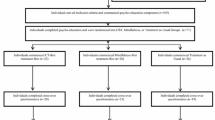Abstract
An innovative pilot treatment program was developed for problem gamblers living in rural areas of Australia using cognitive behaviour therapy (CBT) modified from an established specialist therapy service. The standard 12 weekly group program was delivered on site by adapting it to two 1 week blocks with daily group sessions and 1 week of patient practice between the face to face group sessions. The median SOGS score (8) met the cut off for probable pathological gambling at assessment. All 7 who were assessed as suitable for the program completed the treatment with the median SOGS score of 0 at the end of treatment indicating these clients were no longer pathological gamblers. This was maintained at 12 months for 5 clients who provided follow up measures. Participants experienced a clinically significant change in the severity of their gambling and its impacts. This pilot program proved to be acceptable to rural participants and provides preliminary evidence that this intervention can reduce gambling and improved life functioning. Randomised controlled designs are needed to confirm the efficacy of this treatment approach. This program may provide a model for the treatment of gambling clients with complex co-morbidities in other rural settings.





Similar content being viewed by others
References
American Psychiatric Association. (1994). Diagnostic and statistical manual of mental health disorders (DSM-1 V). Washington: American Psychiatric Association.
Andrews, G., & Hunt, C. (1998). Treatments that work in anxiety disorders. The Medical Journal of Australia, 16, 628–634.
Battersby, M., Ask, A., Reece, M., Markwick, M., & Collins, J. P. (2001). A case study using the “problems and goals approach” in a coordinated care trial: SA health plus. Australian Journal of Primary Health, 7, 45–48.
Battersby, M., Oakes, J., Tolchard, B., Forbes, A., & Pols, R. (2008). Cognitive behavioural therapy for problem gamblers. In M. Zangeneh, A. Blaszczynski, & N. Turner (Eds.), The pursuit of winning problem gambling theory, research and treatment. New York: Springer.
Blaszczynski, A. (1993). Pathological gambling: a treatment review. Psicologia Conductual, 1, 409–440.
Burgiss, S. (2006). Telehealth technical assistance manual. National Rural Health Association.
Delfabbro, P., & Winefield, A. (1999). Poker machine gambling: an analysis of within session characteristics. British Journal of Psychology, 90, 425–439.
Dickerson, M., Hinchy, J., Legg England, S., Fabre, J., & Cunningham, R. (1992). On the determinants of persistent gambling behaviour. High-frequency poker machine players. British Journal of Psychology, 83, 237–248.
Lesieur, H., & Blume, S. (1987). The South Oaks Gambling Screen (SOGS): a new instrument for the identification of pathological gamblers. The American Journal of Psychiatry, 144, 1184–1188.
Lovell, K., & Richards, D. (2000). Multiple Access Points and Levels of Entry (MAPLE): ensuring choice, accessibility and equity for CBT services. Behavioural and Cognitive Psychotherapy, 28, 379–391.
Marks, I. M. (1987). Fears, phobias and rituals. New York: Oxford University Press.
Mundt, J. C., Marks, I. M., Shear, M. K., & Greist, J. H. (2002). The Work and Social Adjustment Scale: a simple measure of impairment in functioning. The British Journal of Psychiatry, 10, 461–464.
Oakes, J., Battersby, M., Pols, R., & Cromarty, P. (2008). Exposure therapy for problem gambling via videoconferencing: a case report. Journal of Gambling Studies, 24(1), 107–119.
Productivity Commission (1999). Australia’s gambling industries, Report No. 10, AusInfo, Canberra.
Taylor, A., Gill, T., Head, L., Pugh, L., Starr, G., Rogers, N., et al. (2005). Gambling prevalence in South Australia Office for problem gambling.
Tolchard, B., & Battersby, M. W. (2000). Nurse behavioural psychotherapy and pathological gambling: an Australian perspective. Journal of Psychiatric and Mental Health Nursing, 7, 335–342.
Toneatto, T., & Ladouceur, R. (2003). Treatment of pathological gambling: a critical review of the literature. Psychology of Addictive Behaviours, 17, 284–292.
Westphal, J. R. (2007). Are the effects of gambling treatment overestimated? International Journal of Mental Health and Addiction, 5, 65–79.
Acknowledgement
We would like to acknowledge the South Australian Department for Families and Communities for providing the funding that made this project possible. We would also like to acknowledge the support of Eve Barrett and the Mount Gambier Lifeline staff who actively contributed to the project and provided support to the clients and therapists.
Author information
Authors and Affiliations
Corresponding author
Rights and permissions
About this article
Cite this article
Oakes, J., Gardiner, P., McLaughlin, K. et al. A Pilot Group Cognitive Behavioural Therapy Program for Problem Gamblers in a Rural Australian Setting. Int J Ment Health Addiction 10, 490–500 (2012). https://doi.org/10.1007/s11469-010-9294-1
Published:
Issue Date:
DOI: https://doi.org/10.1007/s11469-010-9294-1




